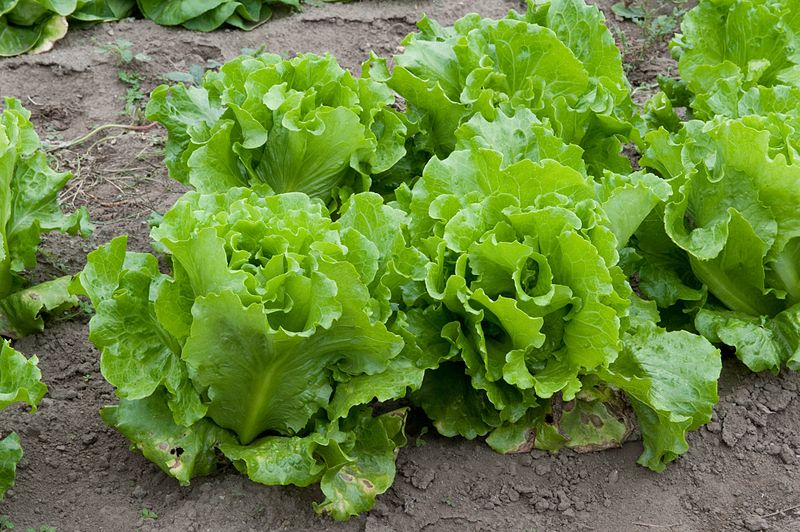Quick to grow, healthy to eat, a versatile ingredient and not associated with unpleasant bodily functions, what’s not to love?
Last week’s veg (Jerusalem artichokes) provoked much hilarity and farting jokes so we’re back on safer ground this week with lettuce. Beyond the bog-standard butterhead and iceberg, it’s difficult to find really great quality, fresh organic lettuce of different varieties in the supermarket.
Lettuce is really easy to grow and relatively quick (about 10–12 weeks from sowing to eating) and with a little planning, you can eat it fresh for most of the year. It’s still not too late to sow lettuce as long as you pick the right winter-hardy varieties and provide some cover (e.g. fleece) in very frosty weather. In fact it’s generally a lot easier growing lettuce in the colder autumn weather, with improved germination and better growth.
Sowing
There are four main types of lettuce. The first three—butterheads, cos and crispheads—form hearts at their centre and are therefore usually grown as proper heads of lettuce. They take longer to mature. The fourth type—loose-leaf—doesn’t form a heart and is therefore generally grown as a cut-and-come-again crop—where leaves are cut as required.
Though you can sow lettuce direct in the soil, I always start my seeds off in module trays in the potting shed and plant them out later—it’s far more reliable that way. Spring and autumn sowings I plant out in the polytunnel, while the summer sowings are generally planted outside in the veg patch. If you are growing heads of lettuce, sow just one seed in each module. With loose leaf types, sow 3–5 seeds per module. Lettuce needs light to germinate so don’t cover the seeds with compost (or if you do, just a very gentle sprinkle). Lettuce will not germinate in temperatures above 25°C so if the weather is warm you may need to move the trays in to a cool shed for a few days until they germinate.
Succession sowing is the way to go. The first time I tried growing lettuce, I sowed a full module tray of 82 seeds, which meant I had 82 heads of lettuce all ready at the same time. Great if you’re catering for a wedding, but not so great otherwise. So the key here is to sow ‘little but often’. I generally sow trays of lettuce every 2–3 weeks from January until October. The last sowing is designed to see me right through the winter months until the new season leaves are ready in March.
Seedlings are ready to plant out when they have 4 or 5 leaves, usually about 4–5 weeks after sowing. In colder weather, harden off well before planting out (in other words, get them used to the colder temperatures outside by bringing them in again at night time for a few days).
Growing
Lettuce will do well in any reasonable soil, as long as it’s moisture retentive—add well-rotted manure or compost the previous winter. Lettuce is a great space filler—you can pop it anywhere you have some space. Spacing is about 20–30cm depending on the type. Plant the seedlings well down in the soil with the cotyledons (seed leaves) just above the soil level. Keep the soil around the plants weed free and water copiously in dry weather—this will help prevent them bolting. Use fleece or cloches to protect early and late sowings from frost.
Harvesting
Cos, Butterhead and Crisphead varieties of lettuce need to be left longer to develop their hearts. Cut leaves of loose-leaf varieties as soon aa they are of usable size. If you cut them about 5cm from the ground they will grow back and you will be able to take a second crop in a few weeks. Harvest lettuce leaves early in the day and they will keep far longer. This is because later in the day the moisture has evaporated from the leaves and so it wilts more quickly.
Recommended Varieties
Mixed Leaf, Dynamite, Little Gem, Brandon, Iceberg, Aruba.
Problems
Lack of water causes the plants to panic and run to seed in a desperate attempt to reproduce before they die. This is called “bolting” and it’s very bad news as the plants are too bitter to eat. Slugs eat young leaves and get in to the hearts of lettuces. Aphids (black or greenfly) can be a problem. Leatherjackets (the larvae of the Daddy Longlegs) eat through the stems of newly planted lettuce.
GIY Tips
- To wash, fill your sink with really cold water and break up the heads of lettuce in to the water. Let it all float in the water for 5 minutes or so. All the grit and dirt (and occasional slugs) will sink to the bottom of the sink and you can then scoop out the clean lettuce. Dry in a lettuce spinner and put in a plastic container with a lid in the fridge—it should keep for 3–4 days.
- Try growing summer lettuce in partial shade—they don’t like hot weather.



